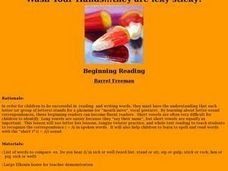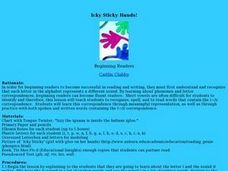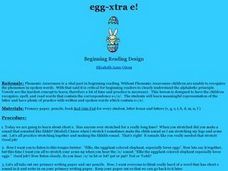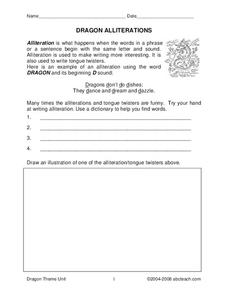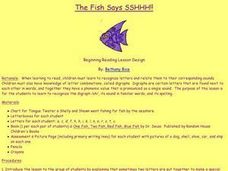Curated OER
U-u-under The U-u-umbrella!
Young scholars practice using phonemes because they need to be able to recognize that phonemes and letters correspond with each other in order to become a proficient reader. The practice is done using the letter "u".
Curated OER
Opera Singer
Students recognize the short vowel o in written and spoken language. Through listening and decoding activities, they discriminate the vowel sound /o/ from other phonemes. Students identify the phoneme and letter in pseudo words they read.
Curated OER
Wash Your Hands...they are icky sticky!
Students engage in an emergent literacy instructional activity that focuses on phonemic awareness and they practice corresponding the letter "i" to its long or short sound. This type of recognition has been found to be essential to...
Curated OER
O-O-O-O-O, I get it!
Students engage in an emergent literacy instructional activity that focuses on the skill of phonemic awareness. To practice the skill the phoneme for the letter "o" is used. The students need to recognize the letter and its corresponding...
Curated OER
Icky Sticky Hands!
Learners examine the letter 'i'. Through instruction and modeling they explore the sound the letter makes, how the letter is written, words that contain the letter, etc. They use letterboxes to write 'i' words and read stories containing...
Curated OER
Icky Stinky Fingers!
Young scholars examine the letter 'i'. Through instruction and modeling they explore the sound the letter makes, how the letter is written, words that contain the letter, etc. They use letterboxes to write 'i' words and read stories...
Curated OER
Icky Fingers
Students are introduced to digraphs so they can match letters to their phonemes. They recognize the short vowel i=/i/ in both spoken and written words by practicing reading and spelling words containing /i/. Elkonin Letter Boxes are...
Curated OER
Shhhhelly Shhhhrimp
Students read and spell words via alphabetic insight that letters stand for phonemes and spelling. They map out the phonemes in spoken words. This lesson will help students identify the letters s and h, along with the sound...
Curated OER
Uhh I don't know!
Students engage in an emergent literacy lesson in order to work on the skill of phonem ic awareness. The use of flashcards is essential for the instruction of the lesson. Students match the card with its beginning phoneme.
Curated OER
Cat Nap
Students identify and interpret the concept of the vowel /a/ and recognize it in words and illustrations. They also practice writing both upper and lower case A on writing paper. Finally, students name pictures and circle the pictures...
Curated OER
Egg-xtra E!
First graders recognize the short vowel e in written and spoken language. Through listening activities, they discriminate the vowel sound /e/ from other phonemes. Students identify the phoneme and letter in words and sentences they write.
Curated OER
Bless You
Students practice recognizing the phoneme /a/ in spoken and written words as well as by symbol. They interact with the book, "The Cat Nap," from Educational Insights and the Dr. Seuss book, "ABC's Book." Each student also plays a memory...
Curated OER
Eddie the Elephant
Students need to practice sight words to become proficient readers. So it is very important for children to learn common correspondences. The phoneme for the letter "e" is practiced in this lesson.
Curated OER
What doe the doctor say?
Learners must explore the phoneme awareness. They must decode many different correspondences. Students explore the o sound by illustrating the concept using memorable tools used in by showing the o sound in spoken and written words.
Curated OER
Fairy Tale Alliterations
Fairy tales are the perfect way to focus on alliteration. Learners complete activities relating to alliteration and similes using a fairy tale theme. Then, they complete an acrostic poem using the words fairy tale.
Curated OER
Chad's Choo Choooo
Choo, choo! Do your youngsters like trains? After studying the target sound, have your learners read A Peach for Chad. Do a class read and an independent read to increase fluency. At the lesson's close, consider creating a ch train where...
Curated OER
Theo and His Thirty Thirsty Brothers
Students recognize the digraph /th/ in both spoken and written words. They read and spell words containing /th/ digraph. They read "Changes in Seasons" by Eizabeth Sengel and make a list of the words containing /th/ digraph.
Curated OER
Dragon Alliterations
Review the definition and an example of alliterations and have your class work on an alliteration project about dragons. They will then write 4 alliterations and draw an illustration of one of the alliterations.
Curated OER
The Fish Says SSHHH!!
First graders identify the digraph /sh/ in written and spoken language. After a brief discussion the independent and combined sounds of the phonemes /s/ and /h/ students practice identifying initial and final placement of the new digraph...
Curated OER
Chug Choo Choo
First graders identify the digraph /ch/ in written and spoken language. After a brief discussion of the independent and combined sounds of the phonemes /c/ and /h/ students practice identifying initial and final placement of the new...
Curated OER
Chomp Chomp Chocolate
Learners identify the digraph /ch/ in written and spoken language. Students practice identifying the initial and final placement of the digraph /ch/ in words by identifying pictures containing the sound. They read a decodable story...
Curated OER
Shhhhh, the Baby's Asleep
Young scholars identify the digraph /sh/ in written and spoken language. After a discussion of the independent and combined sounds of the phonemes /s/ and /h/ students practice identifying initial and final placement of the new digraph...




